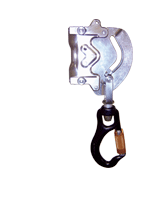A fall arrest system includes a full body harness,
an interconnecting sub system or component designed to arrest
a fall from height and a suitable anchorage.
| Retractable Type Fall Arrester - EN360 |
|
In the event of a fall this
device will lock quickly, arresting the fall and bringing
a person to an abrupt halt, reducing the dynamic loads
imposed on the body at the same time via an integral shock
absorbing system. They are available in may shapes and
sizes, from 2.5m to 60m in length. Some also have retrieval
facilities for use in emergency situations. |
| Shock Absorbing Lanyards – EN354/355 |
|
Available in lengths upto, but never exceeding
2m, lanyards must have energy absorbers to comply with
European Standards. In a fall a user will travel the length
of the lanyard before the fall is arrested. Also useful
as restraining devices to prevent people from getting
too close to the edge of a building. |
| Guided Type Fall Arresters on a Rigid
Anchor Line – EN353-1 |
|
Available in a number of formats these
systems are usually installed to assist in vertical ascent
and descent. An energy dissipating element can be incorporated
into the mobile fall arrester, lanyard or securing support. |
| Guided Type Fall Arresters on a Flexible
Anchor Line – EN353-2 |
|
Usually a nylon or braided safety rope
incorporating a guided type fall arrester with an energy
dissipation element. Good for roof working, ladder access
and pylon work. |
| Work Positioning Devices/Restraint Belts
– EN358/EN359 |
 |
These devices are designed for workers
who are required to work at heights, on poles and other
structues in a supported position that will enable them
to have both hands free for working. These devices are
NOT intended for fall arrest. |
| Harnesses – EN361/prEN1496/1497/1498/020895 |
|
In a work situation where there is a
fall potential a full body harness must be worn. Many
varieties are available, from harnesses with a single
rear D ring, to full multi-purpose harnesses with elasticated
webbing and lumbar support. Other types regularly in
use include sit harnesses, rescue harnesses and even
harnesses with built in life jackets.
Chest and rear D rings only should be used for fall
arrest purposes. |
| Descent Devices |
|
These allow a person to move from a higher
position to a lower position in a controlled manner. Some
do this automatically, whilst others can be controlled
manually by the user. They are often used for rescue purposes
from cranes, towers and high level access equipment. |
| Anchor Devices – EN795/BS7883 |
|
These come in a number of different varieties and you
must never use an anchor device that does not conform
to a European Standard or has not been constructed and
installed for the purpose of fall arrest/restraint by
a professional company that has been able to calculate
the dynamic loads that might be imposed on the structure
and device. |
| Class
A1 |
Structural
anchors designed to be secured to vertical, horizontal
and inclined surfaces such as lintels, walls and columns.
E.G. Safety Eye Bolts |
| Class A2 |
Structural anchors
designed to be secured to inclined roofs |
| Class B |
Transportable
temporary anchor devices such as tripods, cross beams
and girder clamps |
| Class C |
Anchor devices
employing horizontal flexible lines. Systems such as Ariana,
Uniline, Latchways and Sayfglida |
| Class D |
Anchor devices
employing horizontal rigid anchor rails. Systems such
as Hercule Closed Track |
| Class E |
Dead weight anchors
for use on horizontal surfaces |
REMEMBER: An anchorage device is only as good as
the structure it is fixed to and the way in which it has
been fixed. EN795 and BS7883 set out the standards that
are required to be met when considering anchor devices.
Copies are available from the British Standards Institute
DON’T TAKE RISKS ASK THE ADVICE
OF A PROFESSIONAL COMPANY



